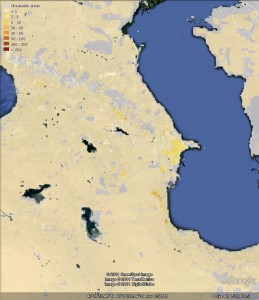Jeremy and/or Andy will no doubt correct me if I’m wrong, because they’re there and I’m not, but I believe it is the very presentation embedded below that was made a matter of only minutes ago by our friend and colleague Andy Jarvis of CIAT at the Special Information Seminar on CLIMATE CHANGE AND GENETIC RESOURCES FOR FOOD AND AGRICULTURE: STATE OF KNOWLEDGE, RISKS AND OPPORTUNITIES at FAO. How’s that for timeliness. If not, then Andy will probably give it at the CGRFA-13 side event on pretty much the same subject on Tuesday. Or maybe both? No online sign of the other presentations yet, but I’ll get the scoop on the event from the boys this evening, I expect.
More on those Azeri buffaloes
Thanks to Elli from the Save Foundation for this comment on our recent post on water buffalo in Azerbaijan.
They were crossed with Murrah in Soviet times, just like in the Ukraine and Bulgaria. I’m just preparing a report on Buffalo in SE Europe and we’ve been looking at the situation in Georgia too.
 Good to know. Incidentally, I should have mentioned another source of livestock information on the previous post: Gridded Livestock of the World (GLW). If you squint, 1 you can just about make out that it does show some buffaloes in Azerbaijan and other countries in the southern Caucasus.
Good to know. Incidentally, I should have mentioned another source of livestock information on the previous post: Gridded Livestock of the World (GLW). If you squint, 1 you can just about make out that it does show some buffaloes in Azerbaijan and other countries in the southern Caucasus.
Nibbles: Breeding, Frankincense and myrrh, Roman pills, Chinese botanic garden, NPGS, Green red bush tea, Old banyan, Terroir, Botanic gardens and invaders, AnGR
- National Organic Coalition suggests USDA’s National Institute for Food and Agriculture separate conventional and participatory breeding from anything involving DNA in considering projects for support.
- Second-guessing the Three Wise Men.
- Yet more on attempts to deconstruct ancient Roman medicines using DNA from tablets found in a shipwreck. Real Indiana Jones stuff.
- Botanic garden and genebank for drought-resistant plants to be established “in Asia’s largest wild fruit forest.” That would be in China. I really don’t know what to make of this. Really need to find out more. But why am I talking to myself?
- Brown (rice) is beautiful.
- Feedback from a genebank user. Kinda.
- Rooibos gets itself certified.
- The oldest cultivated tree on record.
- The taste of Massachusetts.
- “…strongly conservation-minded botanic gardens appear to be in the minority.” Easy, tiger. Will that new one in China (see above) feature in this minority?
- ILRI on an Aussie TV program on conserving local livestock breeds in Africa.
Nibbles: Food Deserts, Garlics, Communication, Bee breeding, Millets, Sweet potatoes, Visualizing herbaria, Medieval beer
- The Economist discovers food deserts. Money quote: “some Americans simply do not care to eat a balanced diet, while others, increasingly, cannot afford to”.
- William Woys Weaver on garlics, and America, and garlic in America.
- Agricultural Communication for Development conference. Sure. But 12 days long?
- Breeding a better bee. And why not?
- Kenya Agricultural research Institute to release three new high-yielding finger millets.
- Too many sweet potato seedlings. What’s a poor breeder to do?
- A visual history of California botanizing.
- Ah, to have lived at a time when a man got most of his calories from beer! No, wait…
Brainfood: Tomato erosion, Cassava starch, Landscape diversity, American chestnut, Niche models, Dormancy genes, Herbarium collections, Indian livestock breeding, Banana breeding, Pollinators, Shattering gene, Participatory research
- The risks of success in quality vegetable markets: Possible genetic erosion in Marmande tomatoes (Solanum lycopersicum L.) and consumer dissatisfaction. Market takes the fun out of landraces.
- Genetic variability of root peel thickness and its influence in extractable starch from cassava (Manihot esculenta Crantz) roots. Starch content depends on dry matter content and peel thickness. About 1500 accessions from CIAT evaluated for the latter, so lots to play around with.
- A meta-analysis of crop pest and natural enemy response to landscape complexity. More landscape complexity means more natural enemies. Still no cure for cancer.
- American Chestnut past and future: Implications of restoration for resource pulses and consumer populations of eastern U.S. forests. Reintroduction of blight-resistant chestnut may have some weird effects on other species.
- Keep collecting: accurate species distribution modelling requires more collections than previously thought. Oh damn.
- Variation in seed dormancy quantitative trait loci in Arabidopsis thaliana originating from one site. Is due to two QTLs. Also flowering time. But no, I don’t understand that “In contrast…” at the end of the abstract either.
- Tracking origins of invasive herbivores through herbaria and archival DNA: the case of the horse-chestnut leaf miner. Another use for old herbarium specimens: finding evidence of pests.
- Animal breeding in India – a time for reflection, and action. The reflection is that genetic improvement has stagnated, so the action needed includes better phenotypic record keeping, more attention to local diversity and community-breeding programmes.
- Performance of micropropagation-induced off-type of East African highland banana (Musa AAA – East Africa). A promising avenue for improvement, the off-types yield more better bananas, a month later.
- Pollination services in the UK: How important are honeybees? Not as important as you might think!
- The same regulatory point mutation changed seed-dispersal structures in evolution and domestication. Cabbage-family fruit development and rice shattering share the same single point mutation.
- Participatory research and on-farm management of agricultural biodiversity in Europe. By Michel “Pimpert”. That should be Pimbert. Old news, but worth mentioning.